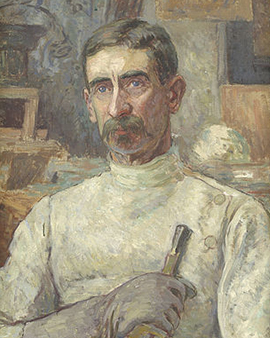A first glance at the works of Georges Lacombe reveals a fascinating interplay of color, form, and symbolism that immediately captivates the viewer. Born in 1868 in Versailles, Lacombe was a French painter and sculptor who played a significant role in the development of Symbolism and Post-Impressionism as a member of the Nabis artists' group. His works are characterized by a poetic visual language, often infused with mythical and spiritual themes. The color palette of his paintings is typically subdued yet expressive, demonstrating a particular fondness for harmonious compositions and decorative elements. Lacombe had a unique ability to create an atmosphere in his works that is both mysterious and meditative.
As his artistic journey progressed, Lacombe increasingly turned to sculpture, with wood becoming his preferred material. His sculptures, including numerous reliefs and free-standing figures, reflect the same sensitivity to form and expression found in his paintings. Particularly noteworthy is his contribution to Symbolist art, where he intertwined motifs from nature, mythology, and the human psyche. Lacombe was closely associated with other members of the Nabis, such as Pierre Bonnard and Édouard Vuillard, drawing inspiration from their experimental approaches. Despite his early death in 1916, he left behind a multifaceted body of work that continues to be recognized in museums and collections worldwide. His art invites viewers to immerse themselves in a world where the visible and invisible merge, offering a quiet yet profound emotional resonance.
×





.jpg)
.jpg)
.jpg)
.jpg)
_-_(MeisterDrucke-951138).jpg)
_-_(MeisterDrucke-951138).jpg)
.jpg)
.jpg)
.jpg)
.jpg)
_-_(MeisterDrucke-1455220).jpg)
_-_(MeisterDrucke-1455220).jpg)
 - (MeisterDrucke-83846).jpg)
 - (MeisterDrucke-83846).jpg)
.jpg)
.jpg)
_-_(MeisterDrucke-1659728).jpg)
_-_(MeisterDrucke-1659728).jpg)
.jpg)
.jpg)
_(oil_on_canvas)_-_(MeisterDrucke-1451251).jpg)
_(oil_on_canvas)_-_(MeisterDrucke-1451251).jpg)
.jpg)
.jpg)
 - (MeisterDrucke-223903).jpg)
 - (MeisterDrucke-223903).jpg)
.jpg)
.jpg)
_-_(MeisterDrucke-566152).jpg)
_-_(MeisterDrucke-566152).jpg)
_-_(MeisterDrucke-556390).jpg)
_-_(MeisterDrucke-556390).jpg)
 - (MeisterDrucke-257567).jpg)
 - (MeisterDrucke-257567).jpg)
.jpg)
.jpg)
.jpg)
.jpg)
.jpg)
.jpg)
.jpg)
.jpg)
_-_(MeisterDrucke-1448586).jpg)
_-_(MeisterDrucke-1448586).jpg)
_1895_Sun_1_-_(MeisterDrucke-1000183).jpg)
_1895_Sun_1_-_(MeisterDrucke-1000183).jpg)
.jpg)
.jpg)
.jpg)
.jpg)
.jpg)
.jpg)






